Whimbrel
A species of Curlews, Also known as Common Whimbrel Scientific name : Numenius phaeopus Genus : Curlews
Whimbrel, A species of Curlews
Also known as:
Common Whimbrel
Botanical name: Numenius phaeopus
Genus: Curlews
Content
Description People often ask General Info
 Photo By silversea_starsong , used under CC-BY-NC-4.0 /Cropped and compressed from original
Photo By silversea_starsong , used under CC-BY-NC-4.0 /Cropped and compressed from original Description
The whimbrel is a shorebird that is often found in coastal areas. It is often present in flocks, mixing with other shorebirds. It is distinguishable by its short, high-pitch whistles that males often emit to warn others of potential predators. A primary food source for the shorebird in the winter is the fiddler crab. Its curved bill allows the bird to easily dig into the crab’s burrow.
Size
43 - 46 cm
Colors
Brown
Gray
Life Expectancy
12 years
Nest Placement
Ground
Clutch Size
2 - 4 eggs
Incubation Period
1 brood
Number of Broods
22 - 28 days
Feeding Habits
Whimbrel predominantly consumes a diet of marine invertebrates such as fiddler crabs, various crab species, crayfish, marine worms, small fish, and mollusks, which they extract from mudflats using their long bills. They display specific behaviors like rinsing their prey and removing large claws before consumption. Whimbrel also partakes in insects, spiders, and various berries on breeding grounds and during migration, sometimes defending feeding territories. Their versatile diet includes food items from both terrestrial and aquatic environments.
Habitat
Whimbrel are typically found in coastal environments, including shores, mudflats, and marshes. These birds prefer areas where altitudes are low to moderate, thriving in climates ranging from the arctic tundra during breeding to tropical zones in winter. Vegetation in these habitats varies from grasses, sedges, and mosses to small shrubs and stunted trees in breeding grounds, while wintering whimbrel favor areas with tidal flats and mangrove swamps. They also utilize inland habitats such as heathlands rich in berry-bearing shrubs and utilize roosting sites like dunes and oyster beds.
Nest Behavior
Whimbrel engages in nesting behaviors that involve selecting a drier, visible area to build their nests.
Nest Characteristics
Whimbrel typically nests on raised sites like hummocks or ridges, often by shrubs for wind protection. The nest is a simple ground bowl, lined with local leaves, grasses, or lichens, measuring around 5.6 inches across and 1.5 inches deep.
Dite type
Aquatic invertebrate eater
General Info
Feeding Habits
Bird food type
Sounds
Call
Recording location: Chile
Call
Recording location: Chile
Song
Recording location: Chile
Behavior
Whimbrel engage in remarkable aerial song flights, especially during the early breeding season, in an effort to attract mates and deter rivals. These elaborate performances involve soaring, gliding, and singing at heights of up to 1,000 feet. Courting rituals between males and females include chases on foot and in the air, along with specialized submissive and display postures. Throughout the incubation period, pairs communicate with trilling calls and share nesting duties, showcasing their monogamy. They often reunite with the same mate in subsequent seasons, establishing loose nesting associations with other pairs. Their territorial behavior includes driving away intruders with threat displays and aerial pursuits, especially aimed at other large shorebird species who enter their breeding territory, which can vary in size. However, this territorial defense reduces post-hatching. Outside of the breeding season, whimbrel exhibit less intense territoriality while feeding and migrate in flocks, often alongside smaller shorebird species, displaying social behavior.
Species Status
Not globally threatened.